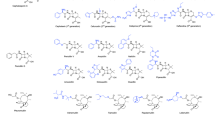Abstract
We report the harvesting of an average of 4,000 kg of saffron milk caps (Lactarius deliciosus Fr.) per day during four to six weeks between mid-October and mid-November in a village of 200 inhabitants in northern Spain. Nearly every inhabitant picks saffron milk caps, for which they receive an average of 2 ε/kg. A family of four could make a profit of 5,600–8,400 ε in a season (average annual income per family in the area is 18,727 ε). Pickers sell the harvested mushrooms either to a local middleman or directly to the buyer, who then takes the produce to the final point of sale, usually in Catalonia, where the demand for saffron milk caps is increasing yearly. This trade has occurred for 30 years, and began when saffron milk caps started to appear in the area after pine trees were introduced to replace the native oaks. This study provides evidence that the collection and marketing of wild edible fungi is a profitable task on a local and national scale.
Similar content being viewed by others
Literature Cited
Arnolds, E. 1995. Conservation and management of natural populations of edible fungi. Canadian Journal of Botany 73 (Suppl. 1):S987-S998.
Arora, D. 1991. All that the rain promises and more. A hip pocket guide to Western mushrooms. Ten Speed Press, Berkeley.
Boa, E. 2004. Wild edible fungi. A global overview of their use and importance to people. Non-Wood Forest Products 17. Rome, FAO.
Cervera, M. 1997. Analisis comercial del sector de la seta silvestre en Cataluna. 6. Escola Tecnica Superior d’Enginyeria Agraria, University of Lleida, Spain.
De Roman, M., and E. Boa. 2004. Collection, marketing and cultivation of edible fungi in Spain. Micologia Aplicada International 16(2):25–33.
Dyke, A.J., and A.C. Newton. 1999. Commercial harvesting of wild mushrooms in Scottish forests: Is it sustainable? Scottish Forestry 53(2):77–85.
Fernandez, M., M. Atienza, A. Rigueiro, and M. Castro. 1993. Production de hongos comestibles en masas de Pinus sylvestris de Soria. Efectos de los tratamientos selvicolas. I Congreso Forestal Espaflol, Tomo 111:363–368.
Martinez de Aragon, J., J. A. Bonet, and C. Colinas. 1998. Production de setas micorrfcicas y comestibles en la comarca del Solsones en 1997. Pages 322–328 in III Forum de Politica Forestal. Centre Tecnologic Forestal de Catalunya. Solsona (Lleida).
Martinez de Azagra, A., and J. A. Oria de Rueda. 2001. Micoturismo en Palencia. Medio Ambiente en Castilla y Leon 15:42–50.
J. A. Oria de Rueda, and P. Martinez. 1997. Estudio sobre la potencialidad de los diferentes usos del bosque para la creation de empleo y actividad economica en el medio rural de Castilla-Leon. La production de mayor potencialidad: Hongos silvestres comestibles. Junta de Castilla-Leon y Fondo Social Europeo, Palencia.
Oliach, D., M. Aguilera, J. A. Bonet, and C. Colinas. 2000. El cultivo del rovellon como elemento de diversification rural. Pages 323–333 in XIII Simposio de cooperativismo y desarrollo rural, Morillo de Tou (Huesca).
Oria de Rueda, J. A. 1991. Bases para la selvicultura y ordenacion de montes productores de hongos micorrizogenos comestibles. Montes 26:48–55.
Perini, C., ed. 1998. Conservation of fungi in Europe. Proceedings of the 4th meeting of the European council for the conservation of fungi. Vipiteno, Italy, 9–14 September 1997. Siena, Universita degli Studi di Siena.
Pilz, D., and R. Molina. 2002. Commercial harvest of edible mushrooms from the forests of the Pacific Northwest United States: Issues, management and monitoring for sustainability. Forest Ecology and Management 155:3–16.
-, and R. Molina, eds. 1996. Managing forest ecosystems to conserve fungus diversity and sustain wild mushroom harvests. Gen. Tech. Rep. PNW-GTR-371. Portland, OR. U.S. Department of Agriculture, Forest Service, Pacific Northwest Research Station.
Roma, J., X. Valios, and C. Colinas. 1997. Relation entre la orientation, la edad del bosque, las claras y el riego, y la production de esporocarpos de hongos ectomicorricicos o comestibles. II Congreso Forestal Espafiol, Tomo 6:525–530.
Samils, N., A. Olivera, E. Danell, S. J. Alexander, and C. Colinas. 2003. Aportacion de la truficultura al desarrollo socioeconomico. Vida rural, 15 diciembre 2003:54–60.
Tedder, S., D. Mitchell, and R. Farran. 2000. Seeing the forest beneath the trees: The social and economic potential of non-timber forest products and services in the Queen Charlotte Islands/Haida Gwaii. Mitchell Consulting and the B.C. Ministry of Forests, British Columbia.
Wasson, V. P., and R. G. Wasson. 1957. Mushrooms, Russia and history. 2 vols. Pantheon Books, New York.
Author information
Authors and Affiliations
Corresponding author
Rights and permissions
About this article
Cite this article
De RomÁn, M., Boa, E. The marketing ofLactarius deliciosus in Northern Spain. Econ Bot 60, 284–290 (2006). https://doi.org/10.1663/0013-0001(2006)60[284:TMOLDI]2.0.CO;2
Received:
Accepted:
Issue Date:
DOI: https://doi.org/10.1663/0013-0001(2006)60[284:TMOLDI]2.0.CO;2




